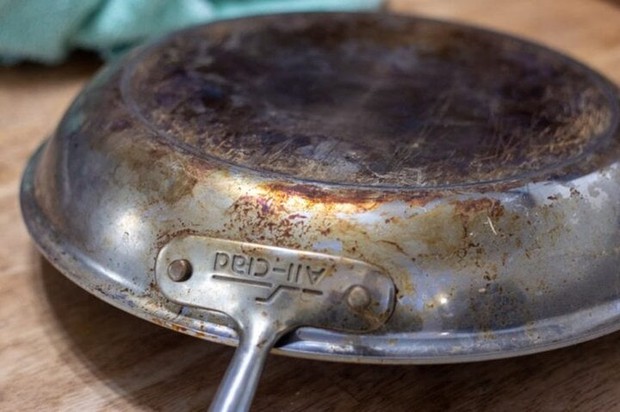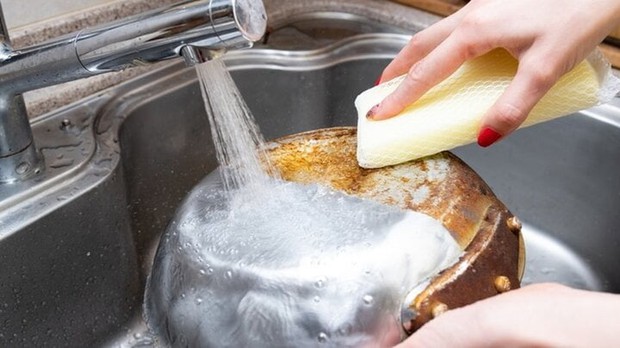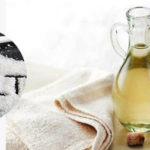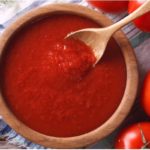When it comes to cooking, almost everyone has had the careless moment of letting the bottom of the pot or pan burn, which can be difficult to deal with. The long-lasting burnt stains on the bottom of the pot not only affect its appearance but also its usability.
Cleaning the burnt bottom of stainless steel pots can “save” you in these situations, using simple ingredients that you already have in your kitchen.
How to Clean Burnt Bottom of Stainless Steel Pots
With common ingredients that are readily available in the kitchen, you can safely and effectively clean the burnt bottom of stainless steel pots.
Use Tomato Sauce
You pour tomato sauce onto the surface of the burnt pot/pan and let it soak for about 30 minutes to 1 hour. Then, you use an aluminum scouring pad to scrub the pot, and finally rinse it with dish soap as usual. The previously burnt bottom of the pot will return to its original state.

There are many ways to clean the burnt bottom of stainless steel pots with ingredients that are readily available in the kitchen. (Photo: Pinterest)
Use Potatoes and Salt
Potatoes contain oxalic acid, which is considered a mild corrosive if combined with salt. This is an effective way to clean the burnt bottom of stainless steel pots.
You clean a potato, cut it in half lengthwise, then dip the cut surface of the potato into salt and scrub it onto the burnt bottom of the pot, repeating until the burnt stains peel off. Finally, you rinse the pot with water to remove all the dirt.
Use Coarse Salt
Salt is an ingredient found in every kitchen, not only used as a cooking spice but also very effective in cleaning burnt bottoms of pots.
To apply the method of cleaning the burnt bottom of stainless-steel pots with coarse salt, first, you pour water over the dirt on the bottom of the pot and then add two tablespoons of salt, stirring well until the salt dissolves.
Soak the pot with this solution for about 1 hour, then scrub it with a dish brush until it’s clean. In case the dirt stains still don’t peel off, you can place the pot with the saltwater on the stove, boil it for another hour, and the dirt stains will be completely removed.
Use Fresh Lemons
Lemons are a familiar cleaning ingredient with good effects in removing stains. To clean the burnt bottom of a pot, you can also use fresh lemons as follows: Prepare 2-3 lemons, cut each lemon into 4 parts, then put them into the pot, pour enough water for the lemons to be submerged.
Put the pot on the stove, boil until you see bubbles rising, then turn off the stove.
Take out the lemon pieces and drain the excess water. Use a dish brush to scrub the remaining burnt stains and rinse with warm soapy water.
Use Vinegar
You can use vinegar to remove stubborn burnt stains in a pot. Cleaning the burnt bottom of stainless steel pots with vinegar is also very simple.
First, you pour about 3 tablespoons of vinegar into the burnt pot along with water and then bring it to a boil, leaving it for about 30 minutes. When the water is boiling, you remove it from the heat to let the steam escape. The stubborn burnt stains will peel off. In addition, the steam from the pot also effectively eliminates odors in the kitchen.
If you don’t boil it, you can soak the burnt stainless steel pot with vinegar overnight and then scrub it in the morning with dish soap, which is also very effective.
Use Cream of Tartar
You need to heat 1 liter of water with 50g of cream of tartar until it is completely dissolved, and then let the mixture cool down. Then, you pour the mixture onto the burnt and rusted part of the pot and use an aluminum scrubber to clean it. Finally, you rinse it with dish soap to remove the stains.

Refer to the ways to clean the burnt bottom of stainless steel pots (Photo: Shutterstock)
Use Baking Soda
You sprinkle baking soda on the burnt surface of the pot/pan and let it soak for 3-8 hours, depending on whether the burnt stains are new or old. Then, you wash it again with dish soap.
If the burn is on the bottom of the pot, you can mix the dish soap mixture with baking soda, add some water, and boil it on medium heat for about 5 minutes, then turn off the heat. When the mixture starts to cool, you will see the burnt layers peel off. At this point, you just need to use a dish scrubber or a pot scrubber to clean it, and rinse with water.
Tips to Prevent Pot Burning When Cooking
The following small actions will help you minimize the burning of pots when cooking.
Clean the bottom of the pot before use
Before using a pot or pan for cooking, especially on electric stoves or induction stoves, you should carefully clean the bottom of the pot to ensure that nothing is left. If there is still food or water on the surface, the bottom of the pot/pan is prone to burning.
Pay attention to the cooking temperature
The cooking temperature should fluctuate at an appropriate level. Prolonged high temperatures are the cause of food or the pot’s bottom burning, especially for easily burnable foods such as sugar, fried foods…
If you want to use high temperatures, you should adjust the appropriate time to turn off the stove and never neglect when cooking to avoid burning or exploding.
Thoroughly clean the stovetop
Oil or food debris may fall onto the stovetop during cooking. If not cleaned thoroughly, they can easily catch fire or become burnt when exposed to heat. This is one of the causes of black burn stains on the bottom of pots or pans. Cleaning the stovetop before and after cooking is necessary to ensure that kitchen utensils are always clean and shiny.
Assessing the Benefits and Drawbacks of Buying vs. Creating Tomato Sauce
Casually cooking up a delicious tomato sauce has become a common activity for many home chefs. With a recipe that is both simple and straightforward, you now have the option to make tomato sauce at home rather than spending money on store-bought alternatives.



































